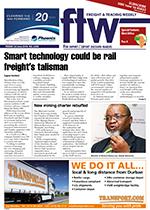West African countries along the Gulf of Guinea are propelling their ports into powerful positions, leaving continental peers in their wake.
“West Africa has fast outpaced the rest of the continent in terms of investing in its ports,” Andrew Shaw, director of transport and logistics at auditing firm Pricewaterhouse Coopers (PwC), told FTW.
One such a port is Tema, the Ghanaian metropolis situated on the Bight of Benin. “They’re investing in a two million twenty-foot equivalent unit (TEU) container facility,” said Shaw who sees it as a clear indication of Ghana’s intent to become the dominant hub in West Africa.
Currently that position belongs to Abidjan, the economic capital of Ivory Coast. However, bolstered by backing from Maersk, “a big player in this region”, Ghana believes that Tema will “take over from Abidjan eventually”. In addition there’s Dakar, capital of Senegal, another port that’s forging ahead, meeting shipping demand and staying ahead of nearby competing ports.
“But it’s a bit of an outlier because it doesn’t sit on the gulf,” Shaw explained. Perched over a map of Africa detailing design capacity vs volume and throughput (see page 8), his index finger follows the concave curve of Africa’s western coast all the way from Dakar down to Cape Town. Mentioning that “it’s a volume game”, Shaw shows how most West African ports have design capacity that exceeds volume.
In some instances, like Conakry (Guinea) and Freetown (Liberia), design capacity overshadows volume because the latter is too low – “not a good thing”. Mostly though, West African ports are evenly balanced with design capacity having a healthy, slight ascending edge over volume. In comparison, for leading ports on the East Coast of Africa, Mombasa (Kenya) and Dar es Salaam (Tanzania), the throughput or ability to adequately process volume “significantly exceeds capacity, resulting in heavily constrained ports with a lot of delay”.
Illustrating the knock-on effect of this, Shaw stressed that it was a big constraint to growth, especially for inland countries like Uganda and Rwanda with fast-growing economies. Even the eastern DRC (Democratic Republic of the Congo) feeds into these ports, beset by issues such as back-of-port incapacity and infrastructural lag.
Poor hinterland road and rail networks don’t make matters any easier. The central Namibia port of Walvis Bay, for example, has excellent capacity but is starved of volume because it’s so remote. And the much vaunted “Lobito line”, linking the Angolan coast with mineralrich areas in equatorial central Africa, “never quite came off as an export destination for traffic from Lubumbashi in the southern DRC”.
Lobito, incidentally, was expected to alleviate congestion in the port of Luanda, the Angolan capital, which compared to other West African ports wasn't coming to grips with strangling congestion problems, he added.
The map that Shaw unfolded to bring FTW up to speed is part of an exhaustive report that PwC compiled and released in April titled, “Strengthening Africa’s gateways to trade.” Explaining what this analysis of port development in subSaharan Africa served to accomplish, Shaw said “what’s happening in other parts of the world is that you have larger ports such as Rotterdam that are well positioned.
“Moreover, their strength is supported by the fact that they have well-established hinterland infrastructure.” When all these components combine, “it allows some European ports to dominate and become large ports. All the traffic comes into these ports and is then disseminated to the smaller ports. Even some UK ports are subservient to these large ports.”
This trend, said Shaw, was visible throughout the world, “even in US where Long Island and Los Angeles have become megaports, dominating ports elsewhere in Northern America.”
This hub trend that’s increasingly becoming the port o’call strategy for shippers controlling post-Panamax plus and other massive vessels, has enabled cities like Abidjan and Tema to lead the cargo game in West Africa.
INSERT
West Africa has fast outpaced the rest of the continent in terms of investing in its ports. – Andrew Shaw


